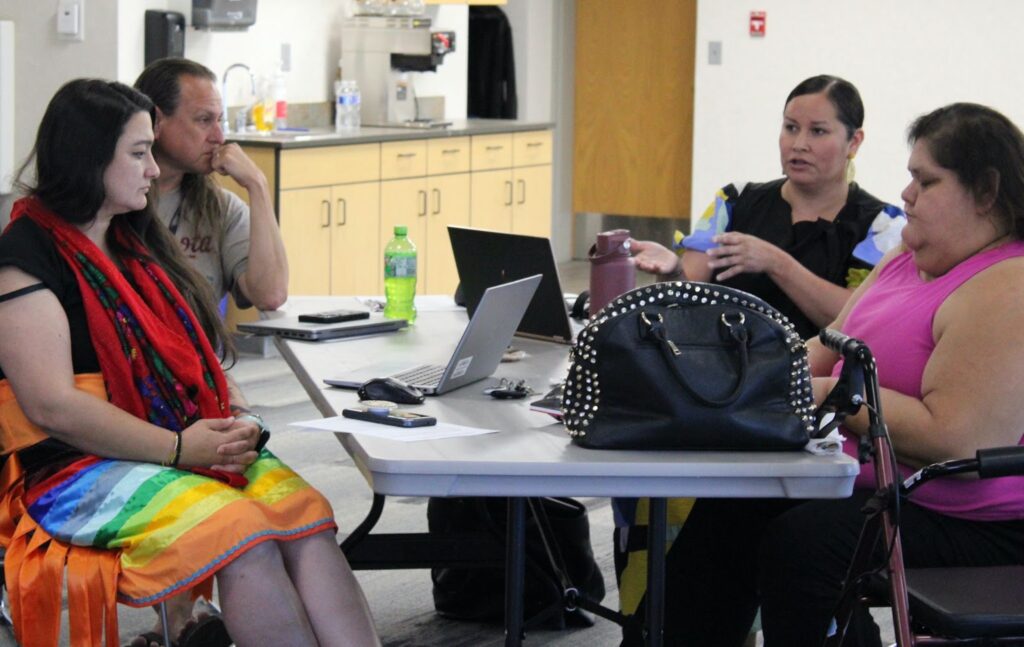
Josh Standing Elk, BPS’s former curriculum and instruction specialist, highlighted the importance of cultural activities and community engagement at the meeting on June 12. (Photo credit/ Adrianna Adame)
Indigenous parents met with Bismarck Public Schools staff in a lively give-and-take at the Hughes Educational Center organized by the district to receive input and discuss how the school could better serve Native students.
The main goal of last Wednesday’s meeting was to talk about the curriculum. Sashay Schettler, the former BPS Indigenous Education Director and now the North Dakota Department of Public Instruction’s assistant director for the Office of Indian and Multicultural Education, led the afternoon meeting. Though she no longer works for BPS, Schettler attended the meeting to discuss her work with the district on inclusivity and Indigenous programs that the cultural coordinators have been working to implement over the past few years.
“In our present world, the school curriculum communicates what we choose to remember about our past, what we believe about the present, and what we hope for the future,” said Schettler. “Right now Indigenous peoples aren’t represented in an accurate or authentically voiced or appropriate way, which is something we have been working on, but we have a lot of work to do.”

One project the district’s Indigenous Education Department worked on was providing schools with flags representing each of the North Dakota state tribes. Schettler said the flags’ purpose is to create a more inclusive environment for Indigenous students.
“Schools like Dorothy Moses Elementary, Wachter Middle School and Bismarck High School researched which students they had, which tribes they represented, and they went and purchased additional flags to make sure those students were represented,” said Schettler. “Some of them went beyond Indigenous students and went to students who are English language learners and immigrants or refugees and they have their flags represented as well.”
Josh Standing Elk, the district’s former Indigenous curriculum and instruction specialist, discussed the work the Indigenous Education Department is doing and spoke about the district’s need to continue its work on community engagement.
Another way BPS has been working with the area’s Indigenous communities is by incorporating cultural activities and events throughout the school year. The cultural coordinators led a dreamcatcher-making event at Solheim Elementary School to celebrate the winter solstice in December. The district invited Jermaine Bell, an Oglala Lakota singer, to perform during events such as Indigenous Peoples’ Day last October. Highlighting the importance of such cultural activities, Standing Elk shared a story about a Native first grader who ran to listen to Bell’s songs when she heard him.
“She heard the drum and went running around the corner, then she peeked around the corner and stayed for the entire time because she could see herself or had experienced something that she felt a connection to,” Standing Elk said.
Phil Warrick, a consultant with Marzano Resources on the High Reliability Schools Framework, spoke about his work with BPS. Warrick has worked with the district to implement the HRS Framework, a model for school excellence meant to increase student achievement, school effectiveness, and professional development.
BPS and parents also discussed the Indigenous Education Department’s strategic plan. Towards the end of the session, Warrick asked parents who they think BPS should collaborate with moving forward: “Who needs to be included? Who are some content experts, some elders, some tribal representatives that, as we begin to think about enacting the strategic plan and getting some of the specifics and building some ideas…Who do we need to talk to?”
Billi Jo Beheler, the chairperson of the Indigenous Parent Advisory Committee, attended the meeting along with other committee members to ask questions about curriculum and the need for inclusivity. Beheler has served as chairperson of the IPAC since 2019.
After Warrick asked the room for further input, Beheler said that while this session discussed important topics regarding Indigenous education, many of these conversations address issues the IPAC has raised for years.
“This committee has been doing the groundwork to the work that you’re doing, and I just think it’s important to always acknowledge where we’re taking this information from,” said Beheler. “Because when we all got on the IPAC five years ago, we talked about being laser-focused. Let’s look at the data. Let’s look at the graduation rates. Let’s look at the in-school suspension. Let’s look at the dropout rate. Let’s look at everything and figure out where we need to support our families.”
Warrick told the room that BPS needs to continue working to foster an inclusive environment moving forward. Even if BPS meets its goals for Indigenous education, the district must continue to work with the community and pay attention to students’ needs.
“But I also want to say this,” said Warrick. “I don’t think it’s ever done. This is one thing I stress with your principals and your schools. When we’re working in the levels of the HRS framework, you’re never done with the level. I never want to look at it and go, oh, we’re done with a safe, supportive, collaborative culture. No, you’re not.”
© Buffalo's Fire. All rights reserved.
This article is not included in our Story Share & Care selection.The content may only be reproduced with permission from the Indigenous Media Freedom Alliance. Please see our content sharing guidelines.







